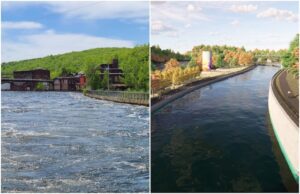Who is a member?
Our members are the local governments of Massachusetts and their elected and appointed leadership.

Montague has secured federal and state funding to transform the old Strathmore Mill site, left, to riverfront open space, as shown in a proposed rendering. (Photo courtesy town of Montague/PLACE Alliance)
Montague is entering the next phase of a plan to clean up the Strathmore Mill site in Turners Falls, a four-acre, multi-building parcel along the Connecticut River that was once home to paper mills.
“It’s an exciting project because it helps to protect the Connecticut River foremost,” said Town Administrator Walter Ramsey. “It’s creating riverfront open space in an environmental justice community, and it’s also supporting hydro generation, which is the biggest economic driver in Montague.”
Ramsey, who served as economic development planner and conservation agent in the town before becoming town administrator, said he has been working on the project since he came to the town 14 years ago. Recently retired Montague Town Administrator Steven Ellis also championed the project during his time with the town.
The Massachusetts Department of Conservation and Recreation awarded $5 million for the project, with another $4.92 million from the U.S. Environmental Protection Agency in a brownfields cleanup grant through the Bipartisan Infrastructure Fund. The brownfields grant will be used to clean a 1.3-acre area of the site with the Strathmore Mill.
The grant awards have been celebrated by the town’s state and congressional delegations.
“This is a big project for a small town [with a population of about 8,500], and the mill itself is of a very significant scale for a small town,” Ramsey said. “These are giant mills that are vacant and entirely unused. So it’s just of a scale that a small town like Montague can’t address on its own. And the industry is long gone and not in a position to be held accountable.”
The town took possession of the property in 2010 through a tax title process in hopes of restoring and redeveloping the site, but it proved infeasible due to site access issues and financial hurdles. The town then determined it would be more suitable to restore the site to natural park land. The buildings have significantly degraded and are at risk of an uncontrolled collapse.
Ramsey said the community has spent significant time developing a vision for the property that would honor its history and importance to the town while protecting important natural resources.
“There’s a lot of rare species at this location, and the river is a popular area for recreational use — for boating, fishing and kayaking,” Ramsey said. “We are also working with our indigenous partners, to have some representation on the landscape, because this is a culturally important property for them as well.”
The town is finalizing the design and permitting for the project and hopes to bid the project for demolition work to begin next summer.
“I would encourage other small towns to think big and have a vision and to really build a network of support with your state and federal partners and regional planning agency,” Ramsey said. “We made our case, showed our vision and were able to get some key champions.”